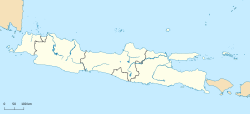Top Qs
Timeline
Chat
Perspective
Mendut
9th-century Buddhist site in Indonesia From Wikipedia, the free encyclopedia
Remove ads
Mendut is a ninth-century Buddhist temple, located in Mendut village, Mungkid sub-district, Magelang Regency, Central Java, Indonesia. The temple is located about three kilometres east of Borobudur. Mendut, Borobudur, and Pawon, all of which are Buddhist temples, are located in one straight line. There is a mutual religious relationship between the three temples, although the exact ritual process is unknown.[1]
Remove ads
History

Built around the early ninth century AD, Mendut is the oldest of the three temples including Pawon and Borobudur. The Karangtengah inscription, the temple was built and finished during the reign of King Indra of the Sailendra dynasty. The inscription dated 824 AD mentioned that King Indra of Sailendra had built a sacred building named Venuvana which means "bamboo forest". Dutch archaeologist JG de Casparis has connected the temple mentioned in the Karangtengah inscription with the Mendut temple.[2]
In 1836 it was discovered as a ruins covered with bushes. The restoration of this temple was started in 1897 and was finished in 1925. Some archaeologists who had researched this temple were JG de Casparis, Theodoor van Erp, and Arisatya Yogaswara.
Remove ads
Architecture
Summarize
Perspective

The plan of the temple's base is square, and measures 13.7 metre on each side, with the base level 3.7 metre above the ground.[3] The 26.4-metre tall temple is facing northwest. The stairs projecting from the northwest side square elevated base is adorned with a Makara statue on each side, the side of the stairwell is carved with bas-relief of Jataka fable narrating the animal story of Buddhist teaching. The square terrace surrounding the body of the temple was meant for pradakshina or circumambulating ritual, walking clockwise around the temple. The outer walls are adorned with bas-reliefs of Boddhisattvas (Buddhist divinities), such as Avalokitesvara, Maitreya, Cunda, Ksitigarbha, Samantabhadra, Mahakarunika Avalokitesvara, Vajrapani, Manjusri, Akasagarbha, and Boddhisattvadevi Prajnaparamita among other Buddhist figures. Originally the temple had two chambers, a small chamber in the front, and a large main chamber in the center. The roof and some parts of the front chamber walls are missing. The uppermost part of the roof is missing, it is supposed to have a stupa pinnacle with size and style probably just like the one in Sojiwan temple. The inner wall of the front chamber is adorned with a bas-relief of Hariti surrounded by children, Atavaka on the other side, Kalpataru, also groups of devatas divinities flying in heaven.

The main room has three carved large stone statues. The 3 metres tall statue of Dhyani Buddha Vairocana was meant to liberate the devotees from bodily karma, at the left is a statue of Boddhisatva Avalokitesvara to liberate them from the karma of speech, and at the right is Boddhisatva Vajrapani to liberate from the karma of thought.[4]
Remove ads
Rituals
During the full moon in May or June, Buddhists in Indonesia observe the annual Vesak ritual by walking from Mendut through Pawon to Borobudur.[5] The ritual takes the form of a mass Buddhist prayer and pradakshina (circumambulation) around the temple.
Followers of traditional Kejawen (Javanese mysticism) or Buddhists, came to worship in the Mendut temple and it is believed to be able to fulfill wishes, such as deliverance from sickness.[3] Childless couples, for example, pray at the bas-relief of Hariti for a child, since in traditional Javanese beliefs, Hariti is a symbol of fertility, patroness of motherhood, and protector of children.[6]
Gallery
- Carvings on a side of the stairwell
- The bas-relief of Hariti on the inner northern wall of Mendut
- A bas-relief of Kalpataru
- A bas-relief of Dharmacakra and Crouching Deers beneath the plinth inside the temple
- Statue of the Vairocana Buddha
- Statue of the Padmapani (Avalokiteshvara) Bodhisattava
- Statue of the Vajrapani Bodhisattava
- Northeastern facade
- A destroyed temple on the northeast of Mendut Temple
- A view from the base of the temple
- Mendut Buddhist Monastery, a present-day monastery that os located next to the site
- Candi Sangharājā in the Mendut Buddhist Monastery, built in the occasion of Vajirañāṇasaṃvara's 100th birthday
Remove ads
See also
References
External links
Wikiwand - on
Seamless Wikipedia browsing. On steroids.
Remove ads















